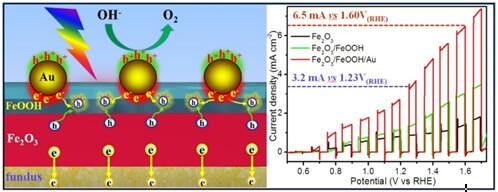The use of solar photovoltaic photocatalytic decomposition of water to make hydrogen is one of the effective means to solve the current energy shortage and environmental pollution. However, at present, the semiconductor material generally has a high photo-generated electron-hole recombination rate, which results in its low photoelectrocatalytic performance and severely limits its practical application.
The Nanocatalytic Materials Group of Energy and Environment of Lanzhou Institute of Chemical Physics, Chinese Academy of Sciences, and Patrik Schmuki, Professor of Erlangen-Nuremberg University, Germany, conducted in-depth and collaborative research. Recently, they have made new progress in the photoelectrocatalytic water splitting of Fe2O3 nanoribbon arrays and the separation of their photogenerated charge.
The researchers in-situ grown a Fe2O3 nanoribbon array with a uniform structure on an iron substrate by a heat treatment method, and selectively built an ultra-thin FeOOH nano-layer and Au nano-particles on the surface thereof, thereby forming a unique structure and high-efficiency photo-generated charge. Separated semiconductor photoanode material. It exhibits excellent photocatalytic water splitting performance and stability under simulated sunlight (AM 1.5G), and the photocurrent densities of 1.23 VRHE and 1.6 VRHE can reach 3.2 and 6.5 mA cm-2. The researchers further studied the mechanism of their photoelectron-hole separation and found that the hot electrons formed by the plasmon resonance effect of Au nanoparticles were injected into the ultra-thin FeOOH nano-layer, while the photo-generated holes generated by the Fe2O3 nano-ribbon array migrated to the FeOOH layer at the same time. And, with the rapid thermal neutralization of Au nanoparticle-injected hot electrons, a hole-consumed layer with a unique photogenerated electron-hole separation effect is formed. However, after the separation of Fe2O3 nanoribbon arrays, the photogenerated electrons rapidly transfer to the counter electrode to participate in the water reduction reaction. At the same time, the hot holes enriched on the surface of Au nanoparticles participate in the water oxidation reaction.
This design structure can effectively promote the rapid separation and migration of photogenerated charge of semiconductor materials, and has certain guiding significance for the construction of high-efficiency solar photoelectrocatalytic water decomposition system. The relevant research results were published in journals such as Nano Energy (2017, 35, 171), ChemSusChem (2017, DOI: 10.1002/cssc.201700522).
The above research work has received funding support from the National Natural Science Foundation of China, Lanzhou Institute of Chemical Industry, and the OSSO National Key Laboratory Project.

Photogenerated Charge Separation of Fe2O3/FeOOH/Au and Photocatalytic Decomposition of Water
Bathroom Sink faucet is heavily used every day between brushing your teeth and washing your hands multiple times. Choose a tub faucet that is not only reliable and water efficient, but also fits your style and budget. We have the latest styles of sink faucets to choose from. Stainless steel bathroom faucets are spot-proof. In addition to resisting spots and fingerprints, the matte black bathroom sink faucet enhances durability.
Bathroom Faucet,Shower Fixtures,Black Bathroom Faucets,Single Hole Bathroom Faucet
JIANGMEN MEIAO KITCHEN AND BATH CO.,LTD , https://www.jmmeiaogroup.com
![<?echo $_SERVER['SERVER_NAME'];?>](/template/twentyseventeen/skin/images/header.jpg)